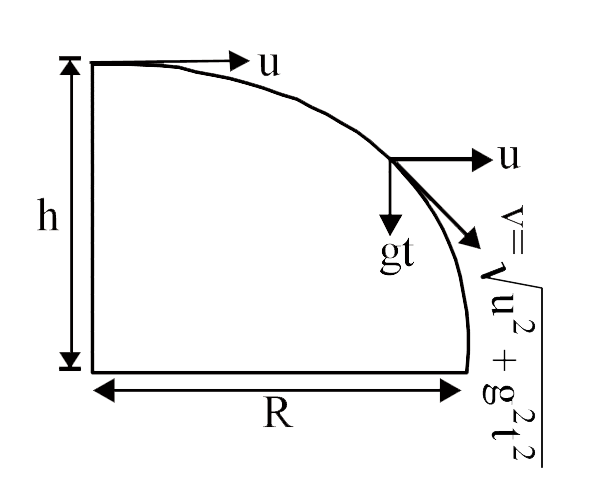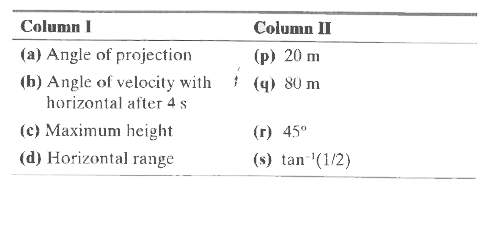Velocity at a general point P(x, y) for a horizontal projectile motion is given by
v=√(v2x+vy2),tanα=vyvx 
αis angle made by v with horizontal in clockwise direction Trajectory equation for a horizontal projectile motion is given by x=vxt=ut
y=-(1/2)gt2 
eliminating t, we get y=−(1/2)gx2u2
An aeroplane is flying horizontally with a velocity of 720 km/h at an altitude of 490 m. When it is just vertically above the target a bomb is dropped from it. How far horizontally it missed the target?
1000m
2000m
100m
200m
Step by step video & image solution for Velocity at a general point P(x, y) for a horizontal projectile motion is given by v=sqrt((v_("x")^(2)+v_("y")"^(2))),tan alpha=(v_(y))/(v_(x)) alphais angle made by v with horizontal in clockwise direction Trajectory equation for a horizontal projectile motion is given by x=v_(x)t=ut y=-(1//2)"gt"^(2) eliminating t, we get y=-(1//2)(gx^(2))/(u^(2) An aeroplane is flying horizontally with a velocity of 720 km/h at an altitude of 490 m. When it is just vertically above the target a bomb is dropped from it. How far horizontally it missed the target? by Physics experts to help you in doubts & scoring excellent marks in Class 12 exams.
Updated on:21/07/2023Similar Questions
elocity at a general point P(x, y) for a horizontal projectile motion is given by
v=√(v2x+vy2),tanα=vyvx
αis angle made by v with horizontal in clockwise direction Trajectory equation for a horizontal projectile motion is given by x=vxt=ut
y=-(1/2)gt2
eliminating t, we get y=−(1/2)gx2u2
5An aeroplane is in a level flying at an speed of 144 km//hr at an altitude of 1000 m. How far horizontally from a given target should a bomb be released from it to hit the target ?
View SolutionVelocity at a general point P(x, y) for a horizontal projectile motion is given by
v=√(v2x+vy2),tanα=vyvx
αis angle made by v with horizontal in clockwise direction Trajectory equation for a horizontal projectile motion is given by x=vxt=ut
y=-(1/2)gt2
eliminating t, we get y=−(1/2)gx2u2
A ball rolls off top of a stair way with a horizontal velocity u m//s. If the steps are h m high and b meters wide, the ball will just hit the edge of nth step if n^(th) equals to
View Solution
Knowledge Check
A projectile is fired from the origin with a velocity v0 at an angle θ with x-axis. The speed of the projectile at an altitude h is .
Av0cosθB√v20−2ghC√v20sin2θ−2ghDNone of theseA projectile is thrown upward with a velocity v0 at an angle α to the horizontal. The change in velocity of the projectile when it strikes the same horizontal plane is
Av0sinα vertically downwardB2v0sinα vertically downwardC2v0sinα vertically upwardDzeroThe electrostatic potential V at any point (x, y, z) in space is given by V=4x2
AThe y- and z-components of the electrostatic field at any point are zeroBThe x-component at any point is given by (−8xˆi)CThe x-component at (1, 0, 2) is (-8i)DThe y- and z-components of the field are constants in magnitude
Trajectory of particle in a projectile motion is given as: y=x−(x2/80) (x and y are in meters). Take g=10m/s2.

View SolutionA mass m moving horizontally (along the x-axis) with velocity v collides and stricks to a mass of 3 m moving vertically upward (along the y-axis) with velocity 2v. The final velocity of the combination is
View SolutionIn a projectile motion, the height y=√3t−5t2+r3 and horizontal distance x=t+2t2−t3 . The angle of projection is given by
View SolutionFor a projectile thrown with a velocity v, the horizontal range is √3v22g. The vertical range is v28g. The angle which the projectile makes with the horizontal initially is:
View SolutionThe equation of projectile is y=16x−x24 the horizontal range is:-
View Solution